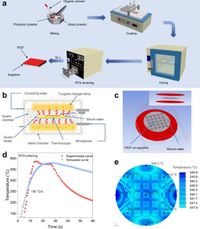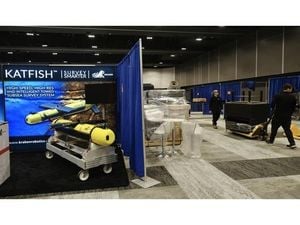In a groundbreaking development for laser lighting technology, researchers have successfully created a rapid thermal annealing (RTA) technique that fabricates high-performance, color-tunable phosphor-in-glass film composites using a high-power-density light source. This new approach addresses long-standing challenges in the production of durable phosphor materials, which have been hindered by issues such as thermal erosion and degradation during traditional sintering processes.
The innovative RTA method can achieve film densification in seconds, with a porosity of less than 3%, through high-power infrared irradiation. Demonstrating its effectiveness, the red-emitting phosphor Sr0.8Ca0.2AlSiN3:Eu2+ processed through RTA exhibited an unprecedented internal quantum efficiency (IQE) of 91.2%. This advancement enables substantial improvements in luminous output, with a luminous flux of 2379 lumens and a luminous efficacy of 140 lumens per watt being achievable post-fabrication.
Traditionally, the processing of phosphor-in-glass film composites involved lengthy high-temperature sintering, which often resulted in the degradation of phosphors and lower overall efficiency. In contrast, the new method significantly minimizes energy consumption, demonstrating that it requires merely 4.3% of the energy used in traditional sintering techniques.
Utilizing a rapid heating rate of approximately 55 °C per second, RTA technology ensures an efficient, scalable method for producing durable phosphor systems suitable for various applications. The method also facilitates high-throughput screening of materials, as demonstrated by the rapid fabrication of phosphor-in-glass films across a 5x5 matrix setup. By carefully optimizing the sintering temperatures and durations, researchers found that a temperature of 550 °C lasted for just 10 seconds yielded the best results for multiple phosphor-glass combinations.
To further illustrate the method's versatility, tests confirmed that the RTA technology could accommodate diverse glass matrices with a range of phosphors, enabling the creation of custom lighting solutions tailored to specific vibrancy and efficiency criteria.
Another notable advantage of the RTA methodology lies in its ability to suppress oxidation during the production process. In tests, the oxidation-induced shift in the emission center was only 3 nanometers compared to a more significant 7 nanometer shift observed in reference samples produced through traditional methods.
As an indicator of the performance enhancements realized through this new technique, RTA-processed phosphor wheels presented remarkable luminescent properties, sustaining over 90% emission intensity even at elevated temperatures of 200 °C, while achieving a luminous flux of 1004 lumens under laser excitation at a density of 27 watts per square millimeter.
The successful applications of these phosphor wheels extend beyond simple light sources; they could revolutionize technologies in display systems and holographic projection, where greater visual quality and efficiency are demanded. As an example, a configuration that combined red-emitting SCASN:Eu and green-emitting β-SiAlON:Eu phosphor wheels delivered a maximum luminous flux of 3502 lumens.
The RTA's efficacy is attributed to its unique heating mechanism, where high-intensity infrared lights distributed evenly throughout the treatment chamber raise the temperature precisely and uniformly. As a result, this method not only improves quality but also significantly reduces production times, paving the way for high-volume manufacturing of top-tier opto-functional materials.
Overall, the rapid thermal annealing method marks a significant leap forward in phosphor synthesis, potentially reshaping the landscape of laser-driven lighting technology and paving the way for innovative display and projection systems that rely on such efficient and tunable light sources.




